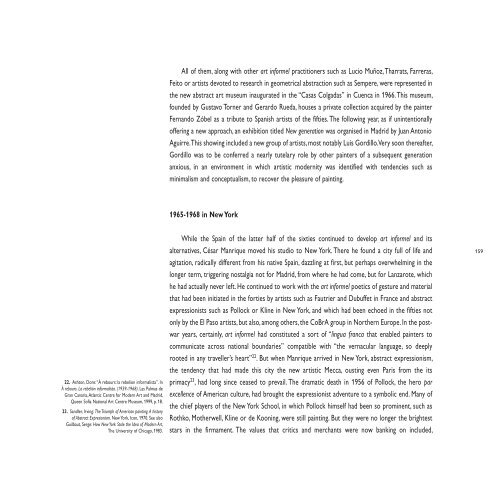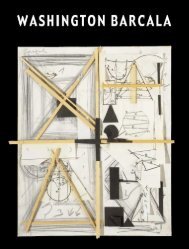VERSIÓN INGLESA ENGLISH VERSION - Fundación César Manrique
VERSIÓN INGLESA ENGLISH VERSION - Fundación César Manrique
VERSIÓN INGLESA ENGLISH VERSION - Fundación César Manrique
Create successful ePaper yourself
Turn your PDF publications into a flip-book with our unique Google optimized e-Paper software.
22. Ashton, Dore: “À rebours: la rebelion informalista”. In<br />
À rebours. La rebelión informalista. (1939-1968). Las Palmas de<br />
Gran Canaria, Atlantic Centre for Modern Art and Madrid,<br />
Queen Sofía National Art Centre Museum, 1999, p. 18.<br />
23. Sandler, Irving: The Triumph of American painting. A history<br />
of Abstract Expresionism. New York, Icon, 1970. See also<br />
Guilbaut, Serge: How New York Stole the Idea of Modern Art,<br />
The University of Chicago, 1983.<br />
All of them, along with other art informel practitioners such as Lucio Muñoz, Tharrats, Farreras,<br />
Feito or artists devoted to research in geometrical abstraction such as Sempere, were represented in<br />
the new abstract art museum inaugurated in the “Casas Colgadas” in Cuenca in 1966. This museum,<br />
founded by Gustavo Torner and Gerardo Rueda, houses a private collection acquired by the painter<br />
Fernando Zóbel as a tribute to Spanish artists of the fifties. The following year, as if unintentionally<br />
offering a new approach, an exhibition titled New generation was organised in Madrid by Juan Antonio<br />
Aguirre. This showing included a new group of artists, most notably Luis Gordillo. Very soon thereafter,<br />
Gordillo was to be conferred a nearly tutelary role by other painters of a subsequent generation<br />
anxious, in an environment in which artistic modernity was identified with tendencies such as<br />
minimalism and conceptualism, to recover the pleasure of painting.<br />
1965-1968 in New York<br />
While the Spain of the latter half of the sixties continued to develop art informel and its<br />
alternatives, <strong>César</strong> <strong>Manrique</strong> moved his studio to New York. There he found a city full of life and<br />
agitation, radically different from his native Spain, dazzling at first, but perhaps overwhelming in the<br />
longer term, triggering nostalgia not for Madrid, from where he had come, but for Lanzarote, which<br />
he had actually never left. He continued to work with the art informel poetics of gesture and material<br />
that had been initiated in the forties by artists such as Fautrier and Dubuffet in France and abstract<br />
expressionists such as Pollock or Kline in New York, and which had been echoed in the fifties not<br />
only by the El Paso artists, but also, among others, the CoBrA group in Northern Europe. In the postwar<br />
years, certainly, art informel had constituted a sort of “lingua franca that enabled painters to<br />
communicate across national boundaries” compatible with “the vernacular language, so deeply<br />
rooted in any traveller’s heart” 22 . But when <strong>Manrique</strong> arrived in New York, abstract expressionism,<br />
the tendency that had made this city the new artistic Mecca, ousting even Paris from the its<br />
primacy 23 , had long since ceased to prevail. The dramatic death in 1956 of Pollock, the hero par<br />
excellence of American culture, had brought the expressionist adventure to a symbolic end. Many of<br />
the chief players of the New York School, in which Pollock himself had been so prominent, such as<br />
Rothko, Motherwell, Kline or de Kooning, were still painting. But they were no longer the brightest<br />
stars in the firmament. The values that critics and merchants were now banking on included,<br />
159
















![Becas y premios de la Fundación César Manrique [1997-2006]](https://img.yumpu.com/20766851/1/184x260/becas-y-premios-de-la-fundacion-cesar-manrique-1997-2006.jpg?quality=85)
